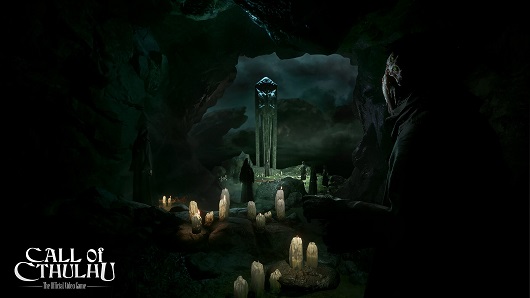Adapting the works of H.P. Lovecraft is always a tricky prospect. Balancing horror with the equally disturbing attitudes that informed the original stories can be a challenge and for all the ways Call of Cthulhu succeeds, it misses the mark in a few more.
• Developer: Cyanide Studio
• Publisher: Focus Home Interactive
• Reviewed on: PlayStation 4
• Also Available On: PC, Xbox One
• Release Date: Available Now

In the opening moments of Call of Cthulhu your character, Edward Pierce, wakes up covered in blood in a subterranean cave surrounded by the corpses of dozens of partially devoured sharks and whales. Pierce’s panic is clear from the outset, the grisly scene leading from one twisted tableau to another until a inexplicable act of violence shocks him awake.
It’s a strong opening that shows what Call of Cthulhu does at its best. The team at Cyanide Studio clearly has a strong understanding of the parts of Lovecraftian horror that work in a visual medium. Eerie sights and sound sound undermine Pierce’s (and the player’s) sense of space and time in the most actively horrific moments, quietly building dread and tension in the moments between.
The story is pure pulp, a boilerplate sets the stage admirably considering the level of cliche. Pierce, a down on his luck private investigator haunted by his traumatic memories of fighting in WW1. Offered a somewhat unusual case, investigating the apparent accidental deaths of a upper class family in a secluded New England fishing town, he sets off for the isolated North Atlantic town of Darkwater. Naturally it all gets very spooky very quickly with mysteries and eldritch secrets aplenty. The issue is that it doesn’t really stay that way.
Mechanically CoC switches between a narrative adventure game, with puzzles to overcome and NPCs to speak to to attempt to gain information, and first person survival horror. This first phase is by far the more engaging. The puzzles make great use of the detailed and unsettling environments, and even the more by-the-numbers challenges are elevated just by the amount of detail in each space. During the course of your investigation you can find hidden objects and lore notes, which flesh out your understanding over ongoing events as well as giving you more prompts in conversations.

Exploration is usually a simple matter of combing the corners and desk drawers for knick knacks. It can be a little too cluttered to make this as simple as it could be, but the design of them overall is interesting enough to keep your attention. The locations are pretty standard, including a creepy port town, a creepy psychiatric hospital and a creepy art gallery. But they’re designed with enough care and attention that you get a feel for Darkwater Island in all it’s dank, haunting glory.
Stealth is very similar to other horror games of recent years, such as Amnesia: The Dark Descent and Outlast. Combat is not an option and the only way to survive an encounter with foes, be they human miscreants or unspeakable creatures from the worlds beyond, is to run and hide. But you can only hide for so long before claustrophobia and panic overwhelm you, and you are discovered anyway. This fits well with the cthulhu mythos attitude but pacing means that it can become tedious. Seeing a threat for the first time can be chilling, but if it see the same identical death animation half a dozen times it begins to lose impact and is replaced with the desire for it just to hurry up end.
One of the tropes of Lovecraftian horror is that the creatures of the Mythos are so mind shatteringly unfathomable that just looking at them is enough to drive the protagonist insane. This works perfectly well in a novel, because the character only gets a fleeting glimpse of the offending creature once before they run screaming into the night. But in a game the illusion gets broken quickly, not least because the stealth sections are difficult. Hiding in a cupboard from a eldritch being is terrifying the first time it happens, but after the tenth time its difficult to summon much of a reaction.

The other facet of Lovecraft’s work that makes it difficult to adapt unchanged from the original work is the racism. The collected works of Lovecraft are intrinsically informed by the author’s bigotry and any modern adaptation has to walk a very fine line in order not to reiterate those same views.
Call of Cthulhu tries to deal with this by not dealing with it, so to speak. For all that the town of Darkwater is a reflection of Lovecraft’s Innsmouth, the worst things of that story’s fear of interracial marriage. The fear of inhuman bloodlines merging with the author’s own is externalised, replaced with mad science and rogue experimentation.
While this is certainly better than leaning wholesale into the original metaphor, it leaves the original without criticism or comment in the game itself. Plenty of works have drawn on Lovecraft’s work and not made a direct comment, but given the way Call of Cthulhu literally uses the name of his most famous work the lack of commentary is a little disappointing.
When Call of Cthulhu is at its best, it is an intriguing mystery, knowing and using the tropes of the genre it calls home. The stealth horror is less than perfectly executed but the writing provides just enough atmosphere and schlock to keep you the tension up. Hardly spec-tentacular, but far from maddening.






